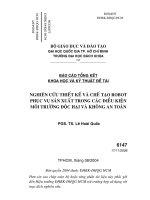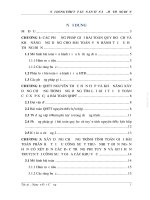Luận án tiến sĩ nghiên cứu về điều kiện môi trường hàng hải từ góc nhìn liên quan tới năng lực sĩ quan hàng hải (study on difficulty of navigational environment from the viewpoit of marines competency)
Bạn đang xem bản rút gọn của tài liệu. Xem và tải ngay bản đầy đủ của tài liệu tại đây (318.39 KB, 7 trang )
Luận án tiến sĩ
Doctoral dissertation
NGHIÊN CỨU VỀ ĐIỀU KIỆN MÔI TRƯỜNG HÀNH HẢI TỪ
GĨC NHÌN LIÊN QUAN TỚI NĂNG LỰC SĨ QUAN HÀNG HẢI
STUDY ON DIFFICULTY OF NAVIGATIONAL ENVIRONMENT
FROM THE VIEWPOINT OF MARINER’S COMPETENCY
Tháng Ba 2009
March 2009
Khoa đào tạo sau đại học
Đại học Hải dương Đơng Kinh
Khóa tiến sĩ Nghiên cứu Môi trường Hàng hải Ứng dụng
Graduate School of Marine Science and Technology
Tokyo University of Marine Science and Technology
Doctoral Course of Applied Marine Environment Studies
HÀ NAM NINH
STUDY ON DIFFICULTY OF NAVIGATIONAL ENVIRONMENT FROM THE
VIEWPOINT OF MARINER’S COMPETENCY
HÀ NAM NINH
2009.3
Contents
Acknowledgements .............................................................................................................1
Abstract ..............................................................................................................................3
Chapter 1 Introduction ......................................................................................................5
1.1. Navigation Environmental Difficulty ........................................................................5
1.2. Nine Elemental Technique for Safe Navigation ........................................................6
1.3. Condition of Safe Navigation ...................................................................................7
1.4. Ship Handling Simulator ........................................................................................10
1.5. Outline of Thesis ....................................................................................................10
Chapter 2 Competency of Bridge Team and Single Watch and Estimation on
Necessary Tasks in the Navigational Environment .........................................................15
2.1. Introduction on Purpose of Chapter ........................................................................15
2.2. Experiments of Approaching Uraga Pilot Station ....................................................15
2.3. Tasks for Mariners in Experiments .........................................................................16
2.4. Data Analysis on Competency of Bridge Team and Single Watch ...........................17
2.4.1. Controlling Ship’s Position and Adjustment of Arrival Time at Pilot Station .19
2.4.2. Collision Avoidance ......................................................................................21
2.5. Summary and Reason of Analyzing Bridge Team Behaviours .................................23
Chapter 3 Necessity of Lookout .......................................................................................27
3.1. Introduction on Elemental Technique of Lookout ...................................................27
3.2. Estimated Factors on Necessity of Technique of Lookout .......................................28
3.3. Experiments for Study of Necessary Tasks for Safe Navigation ..............................29
3.4. Some Definitions Using in Thesis ..........................................................................29
3.4.1. Definition of Crossing Angle ........................................................................30
3.4.2. Definition of Interval of Lookout on One Target ...........................................30
3.4.3. Definition of Time Consumption of Lookout on One Target Ship from Detection
Point to Understanding Motion and Estimating Future Situation .............................31
i
3.4.4. Unit of Information, Content of Information .................................................31
3.4.5. Method of Observation for Gathering Necessary Information .......................33
3.5. One Example Showing Lookout Process from Detection Point to Understanding
Target Motion and Estimating Future Situation in Good Visibility .................................35
3.6. Time Consumption for Lookout on Target Ship from Detection until Understanding
Target Motion and Estimating Future Situation under Effect of Crossing Angle ............36
3.7. Interval of Lookout on Target Ship under Effect of Crossing Angle ........................40
3.8. Necessary Measuring Number of Units of Information in Relation with
Crossing Angle .............................................................................................................43
3.8.1. Necessary Measuring Number of “Rough Bearing” ......................................43
3.8.2. Necessary Measuring Number of “Rough Distance” .....................................44
3.8.3. Necessary Measuring Number of “Rough Aspect” and “Ship’s Type” ...........45
3.8.4. Necessary Measuring Number of “Rough Crossing Angle” ...........................46
3.8.5. Necessary Measuring Number of Bearing .....................................................46
3.8.6. Necessary Measuring Number of Distance ....................................................47
3.8.7. Necessary Measuring Number of Course or Speed or CPA or TCPA .............48
3.8.8. Necessary Measuring Number of BCR or TCBR ..........................................48
3.8.9. Necessary Measuring Number of “Passing Situation” ...................................49
3.9. One Example Showing Lookout Process from Detection Point to Understanding
Target Motion and Estimating Future Situation in Poor Visibility ..................................49
3.10. Comparing Time Consumption for Lookout from Detection Point to Understanding
Target Motion between Two Cases Poor Visibility and Good Visibility .........................50
3.11. Interval of Lookout under Effect of Visibility .......................................................52
3.12. Necessary Measuring Number of Units of Information in Poor Visibility ..............54
3.12.1. Necessary Measuring Number of Bearing by Radar/ARPA
in Poor Visibility ....................................................................................................54
3.12.2. Necessary Measuring Number of Distance by Radar/ARPA
in Poor Visibility ....................................................................................................55
3.12.3. Necessary Measuring Number of “Rough Crossing Angle” or Course
or Speed or CPA or TCPA by Radar/ARPA in Poor Visibility ..................................55
ii
3.12.4. Necessary Measuring Number of BCR or TBCR
or “Passing Situation” by Radar/ARPA in Poor Visibility .......................................56
3.13. Summary of Lookout Tasks ..................................................................................56
3.13.1. Lookout in Good Visibility .........................................................................57
3.13.2. Lookout in Poor Visibility ...........................................................................59
Chapter 4 Necessity of Positioning ..................................................................................61
4.1. Introduction on Elemental Technique of Positioning ...............................................61
4.2. Estimated Factors on Necessity of Technique of Positioning ..................................62
4.3. Experiments ...........................................................................................................62
4.4. Time Consumption for one Position Fixing ............................................................63
4.5. Necessary Number of Position ...............................................................................63
4.5.1. Effect of “Channel Width” ............................................................................64
4.5.2. Effect of “Shape of Channel” ........................................................................64
4.5.3. Effect of “One Risky Target” ........................................................................65
4.5.4. After Avoiding Action ...................................................................................66
4.5.5. Positioning after Avoidance in Concerning with Crossing Angle
of Risky Target .......................................................................................................67
4.5.6. Effect of Visibility on Necessity of Positioning .............................................68
4.6. Summary ................................................................................................................68
Chapter 5 Necessity of Maneuvering ...............................................................................73
5.1. Introduction on Elemental Technique of Maneuvering ............................................73
5.2. Experiments ...........................................................................................................73
5.3. Tasks of Maneuvering ............................................................................................74
5.4. Definition of Time Consumption for Maneuvering .................................................75
5.5. Time Consumption for Maneuvering under Effect of Channel Width ......................75
5.6. Time Consumption for Maneuvering under Effect of Altering Point .......................76
iii
5.7. Time Consumption for Maneuvering under Effect of Visibility ...............................77
5.8. Summary ................................................................................................................78
Chapter 6 Necessity of Communication ........................................................................81
6.1. Introduction on Elemental Technique of Communication .......................................81
6.2. Experiments ...........................................................................................................81
6.3. Unit of Information, Content of Information ...........................................................82
6.4. TCPA of Target Ship at Starting Point of VHF Communication ..............................84
6.5. Average Time Consumption for one Unit of Information ........................................86
6.6. Content of Communication ....................................................................................86
6.6.1. Information for Identifying Target Ship .........................................................86
6.6.2. Information for Identifying Own Ship ...........................................................88
6.6.3. Information Exchanging between Ships ........................................................90
6.6.3.1. Number of Exchanging Units of Information under Relation
with CPA .......................................................................................................90
6.6.3.2. Number of Exchanging Units of Information under Relation
with Visibility ................................................................................................91
6.6.3.3. Content of Exchanging Information ...................................................92
6.7. Summary ................................................................................................................93
Chapter 7 Safe Navigation Assessment .........................................................................97
7.1. Concept of Safe Navigation ....................................................................................97
7.2. Summary of Required Tasks under Effect of Environment ......................................98
7.2.1. Summary of Technique of Lookout ...............................................................98
7.2.2. Summary of Technique of Positioning .........................................................101
7.2.3. Summary of Technique of Maneuvering ......................................................102
7.2.4. Summary of Technique of Communication .................................................103
iv
7.3. Calculation of Time Allowance for Mariners on Wheelhouse ...............................105
7.3.1. Calculating TCPA1 at the Detection of Target Ship .....................................106
7.3.2. Determine TCPA2 at the Finishing of VHF Calling .....................................108
7.4. Example for Assessing Safe Navigation ...............................................................109
Example 7.1 .........................................................................................................109
Example 7.2 .........................................................................................................113
7.5. Using Standard Value for Assessing Safe Navigation ............................................117
7.6. Some Other Studies Assessing Difficulty of Environment ....................................117
Conclusions ..................................................................................................................... 119
Necessary Tasks for Technique of Lookout .................................................................119
Necessary Tasks for Technique of Positioning .............................................................122
Necessary Tasks for Technique of Maneuvering ..........................................................124
Necessary Tasks for Technique of Communication ......................................................125
References .......................................................................................................................127
Abbreviations .................................................................................................................129
Figures ............................................................................................................................131
Tables ..............................................................................................................................209
Tóm tắt (Abstract in Vietnamese) .................................................................................225
v









